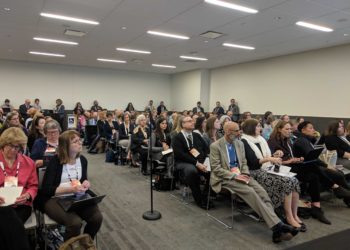Editor’s Note: Today’s post is by Tim Lloyd. Tim is founder and CEO of LibLynx, a company providing Identity, Access, and Analytics solutions for publishers and libraries. Tim serves as the co-chair for the SSP’s Annual Meeting Program Committee.
One of the most challenging aspects of the pandemic has been the need to isolate ourselves from our communities. We’ve all experienced this in our personal and work lives, and we’ve all developed coping measures in response, with varying degrees of success. Necessity has certainly proven the mother of invention over the last two years.
An important example of this is last year’s virtual SSP conference. Following the cancellation of SSP’s 2020 Annual Meeting, the 2021 meeting was born out of the need to come together as a community at a time when physical meetings weren’t feasible (and continue to prove challenging). It was also a massive experiment for SSP — the first virtual annual meeting in our history, and one that had to be rapidly planned and executed as it became clear that our traditional in-person conference wasn’t going to happen.
Delivering the 2021 virtual meeting was a huge achievement by last year’s Annual Meeting Program Committee. But this post is forward-looking, because innovation is never a destination we arrive at but rather a journey we take, so it’s important for us to reflect on both what we have accomplished and what we can improve. In particular, what can we learn from our experience of the 2021 meeting that can inform future annual meetings, whatever the format?

To answer this question, the Annual Meeting Program Committee formed a working group to review the results of the 2021 meeting and develop recommendations for future annual meetings, whether in-person, virtual, or hybrid. The group also solicited feedback from participants about their experiences at our meeting and at other online meetings they’ve attended since the start of the pandemic in March 2020.
Our recommendations are summarized below, and we will be applying some of them to this year’s in-person meeting. For example, we plan to provide more structured guidance to help attendees re-acclimatize to in-person meetings after [gulp] two years of virtual meetings (#2); we will structure networking sessions around smaller, more intimate groups to encourage participation (#3); and we are exploring ways to more effectively incorporate virtual feedback into in-person discussions (#6).
If you have feedback on these recommendations, or other thoughts on how to improve the effectiveness of our annual meetings, please share them in the comments section below.
- Segment marketing
Develop marketing targeted at key segments of the the community, such as early career
professionals, C-suite executives, researchers, and librarians, to more effectively communicate the upfront benefits of attendance to these communities and encourage more non-members and first-time attendees to register. Suggestions include providing templated messaging to share with managers promoting the benefits of sending early career professionals, and video interviews with participants from each segment.
- Help people re-acclimatize to in-person meetings
Most of us have not experienced an in-person meeting for two years or more. To encourage people to attend in-person meetings, we should consider strategies to help them re-acclimatize to an in-person experience. Suggestions include easily visible and accessible visual cues to indicate an attendee’s comfort level with physical contact, and clear guidance on the safety policies and protocols in place.
- Re-create the benefits of virtual networking
Structure in-person networking to re-create the benefits we’ve experienced with virtual networking. For example, limiting the number of attendees at in-person networking events so it’s easier to build rapport, and setting pre-determined agendas so attendees bring a shared interest and have a clear start for conversations (ideally with a moderator to kick-start and guide the process).
- Encourage greater creativity from session organizers
Proactively encourage session organizers to be more creative about formats in order to engage
audiences and broaden inclusivity, especially when the conference is hybrid or fully virtual. Suggestions include providing specific guidance on creativity and sharing examples of creative sessions.
- Create more integrated vendor opportunities
Integrate vendors into conference events through expanded sponsorship opportunities to supplement in-person exhibit halls — in-person or virtual. Suggestions include exploring ways to integrate industry breakout sessions into conference programming.
- Dedicated moderators for virtual feedback
While the 2022 SSP annual conference is primarily an in-person event, there is an option to participate in some elements virtually. However, incorporating virtual feedback into sessions is challenging because of the volume and lack of threading to knit together related themes. Dedicated moderators would enable sessions to effectively incorporate feedback from virtual attendees by reviewing online feedback across channels (video app, conference app, Twitter, etc.) and bringing questions to the session moderator and/or presenters.
Finally, I’d like to thank the other members of our working group who invested their time in several long and lively discussions: Aly Brunson, Kath Burton, Marianne Calilhanna, Lori Carlin, Greg Fagan, Yael Fitzpatrick, Paul Gerbino, Simon Holt, Kurt Jordan, and Damita Snow.
Discussion
4 Thoughts on "Guest Post — Learning from the Experience of SSP’s 2021 Virtual Annual Meeting"
Thanks for this overview. I was disappointed to see that this year’s meeting is in person only. Are the virtual elements you mention available only to attendees? Are you doing anything to accommodate attendees and presenters who are not able to be there so as not to exclude, for example, those who are immunocompromised or people with young children who can’t yet be vaccinated?
SSP is actually offering a virtual attendance option with a mix of live and on-demand content. All keynotes, plenary sessions, and selected educational sessions will be streamed live June 1-3, 2022. Streams will include speakers and any presentation materials. Virtual attendees can submit questions to speakers during these sessions via a chat facilitator. Participants can also chat in real time with other virtual attendees via the meeting platform for online networking. Several additional online networking opportunities will also be available for virtual attendees.
Recordings of all other sessions in the program will be available on demand in the meeting platform/app within 24 hours after the session occurs. The meeting platform/app will also contain access to posters.
There is a registration fee to attend virtually and you can find more information about the virtual attendance offering here: https://customer.sspnet.org/SSP/Events/2022-Annual-Meeting/Virtual-Attendance-Info/ssp/AM22/Virtual-Attendance.aspx?hkey=ebace984-8e1c-41da-9368-a50906545349
I’m glad to see that — but what about presenters? Are they able to present remotely? I ask because I am starting to see colleagues miss opportunities in the move toward in-person events.
We are requesting that speakers participate in-person. There may be a few exceptions where a certain perspective is necessary and travel isn’t an option and we are evaluating those on a case-by-case basis. As we return to in-person, we really want the attendees that are traveling to Chicago to be interacting with speakers in the room vs watching them on a screen, especially since networking is a critical aspect of the SSP Annual Meeting. We offer a variety of virtual events throughout the year where remote speaking opportunities are available and we plan to continue to do so.



